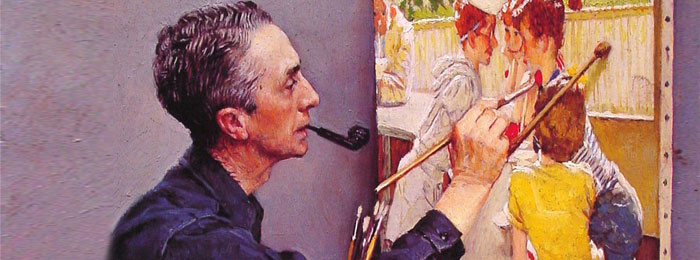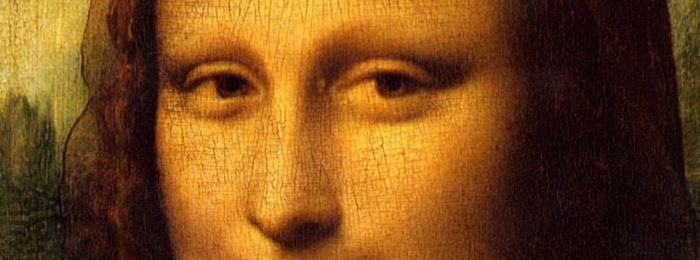On 1 Aug, 2015 With
Acrylic Paint or Oil Paint? Trying to decide which type of paint to use to paint your next art masterpiece? Should you go with the tried and true oil paints, or should you try the newer medium of acrylic paint? Each of these types of paints has their pros and cons which you should investigate so that you can choose the medium that suits your painting style. You are the artist, you make the call. Oil paint, the traditional medium, is basically powder pigments mixed with clear linseed oil. This paint is slow drying and for that reason is perfectly suited for blending colors together smoothly with plenty of time to contemplate the painting’s progress and still have time to…
Read More
On 14 Jul, 2015 With
Vitruvian Man Helps Decode the Mona Lisa The Yin and Yang qualities of the two cojoined forms of the Vitruvian Man and those of the Mona Lisa (both considered to be self portraits of Leonardo Da Vinci)help us to experience our own wholeness. This leads to greater peace and happiness. These Yin and Yang qualities are also found in the Star of David and Christian Cross. Leonardo said it best: “The outstretched arms and legs of a man form a square and a circle: the square symbolizes the solid physical world and the circle the spiritual and eternal. Man bridges the gap between these two worlds.” -Leonardo Da Vinci, “The Magical Proportions of Man” Leonardo Da Vinci’s Vitruvian Man (the…
Read More
On 14 May, 2010 With
One of the biggest hurdles for beginner oil painters is learning how to keep colors pure. How many times have you started an oil painting only to quit from frustration because things just didn’t look right. Your colors were muddy or they just lacked brilliance. This is a very common problem for artists just starting out with oil paints. Hopefully after reading this article, you will no longer have to put up with this frustration any longer and will finally be able to enjoy oil painting.BE CLEAN AND ORGANIZEDI know for some of us, it can be very difficult to maintain a clean and organized painting environment. Sometimes we can get very caught up in our work and things can…
Read More
On 2 Apr, 2010 With
Compared to other mediums of painting such as water colours or acrylic or charcoal and so on, oil paintings have always been a favourite medium for artists as well as art lovers. However, the oil medium has its own peculiarities particularly with respect to how it weathers the passage of time. For an oil painting to retain its original shine and form, the artist or the collector needs to maintain it carefully. Particularly if you are an art lover or collector who owns one or several oil paintings, the best way to maintain the paintings is to get some professional help to clean or refurbish your valuable collection. But hiring a professional can be quite expensive and time consuming. If…
Read More
On 1 Nov, 2009 With
As an artist you are creative by nature, which means the business aspects of marketing and selling may feel uncomfortable. Developing an online presence can help with the process. Each online activity creates permanent evidence that you have been there and serves as a marketing assistant helping to market and sell your work 24/7. There are many such activities an artist can utilize. Here are seven. 1. Register with online portfolio services. Before registering, write a brief statement explaining who you are as an artist and other information important to clients. This can be as short as two words or as long as a paragraph. Also, choose the one image that conveys who you are as an artist this will…
Read More
On 7 Oct, 2009 With
Canvas is a sturdy plain woven fabric used to make tents, sails, marquees, backpacks, canoes, trampolines and tarpaulin, all of which are for outside use but (linen) canvas replaced wooden panels as the favoured medium for oil painting artists around the time of the 17th century. Historically, canvas was made from hemp, before being replaced by linen, but more common these days is cotton canvas due to it being economical and versatile. Canvas comes in two forms, plain and duck, the latter being more tightly woven and used extensively for outdoor applications, such as clothes, camping and sailing. In the 20th century, cotton canvas replaced linen canvas as the most popular painting medium, although linen canvases are still used to…
Read More
On 25 Jan, 2006 With
Creativity is a tricky endeavor. To get the right look, you need the right materials. As any artist knows, anything can serve as a canvas, but for the truly exquisite look, you need something special. In this short guide, we’ll explain some of the art and craft products available and some possible applications for these products. Curious iridescent paper is certainly one of the oddest products on the market today. Normally, embossed iridescent paper is not so much a paper, but more like plastic or a thin, flexible and colorful metal, and as such, is well suited for sculpting and other crafts. Iridescent paper is often made by foil stamping and lasers on light-sensitive chemicals, and can only be used…
Read More
On 6 Mar, 2005 With
Scumbling techniques have been used by master painters since the 1600s to create smooth gradations, modify a previously dried layer of paint and to add a sense of depth. This technique is accomplished by applying thin layers of light opaque colors over dark layers of dried transparent paint. The final results gives a painting a surface that various in how much of the under painting is revealed. An ultra thin layer of an opaque paint can soften an area of a painting while giving it a misty, almost out of focus look that might be typical of background objects. Adding a thicker layer of paint to an area would naturally give that object an appearance of being in the foreground….
Read More
On 5 Dec, 2004 With
In this article I will discuss the tube colors belonging to an advanced palette based on a basic 6-color palette. I find these colors the most useful and often necessary to round out a versatile palette. The 6-color basic palette consists of the following colors: 1. Lemon Yellow 2. Cadmium Yellow 3. Cadmium Red 4. Permanent Rose 5. French Ultramarine 6. Phthalo Blue To these 6 colors we, of course, add 7. Titanium White 8. Ivory Black Note that you can already create amazingly diversified paintings with the above palette. But, for various reasons, artists tend to add a variety of other colors to their palette. One reason is that tube colors are, by and large, always brighter…
Read More
On 7 Mar, 2004 With
Most of us like to paint different things. Some of us are professional painters while some of us just paint for fun. If you are serious about the subject it’s very important that you have some knowledge about the different types of paint brushes. Paint brushes are made up from stiff or soft hairs, which are either natural hairs or synthetic fibers. Soft brushes are specially designed for thin paints as they spread easily. Similarly incase of hard strokes you need hard brushes for creating brush marks in the paints. Is natural hair better than synthetic? Natural hair paint brushes are expensive as compared to the synthetic brushes. The modern synthetic brushes are excellent and have flexibility to beat even…
Read More



